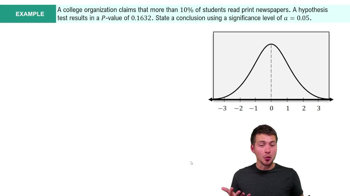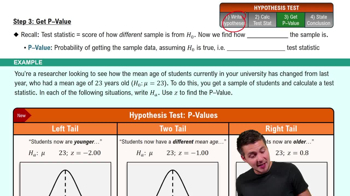Estimates vs. Hypothesis Tests Labels on cans of Dr. Pepper soda indicate that they contain 12 oz of the drink. We could collect samples of those cans and accurately measure the actual contents, then we could use methods of Section 7-2 for making an estimate of the mean amount of Dr. Pepper in cans, or we could use those measured amounts to test the claim that the cans contain a mean of 12 oz. What is the difference between estimating the mean and testing a hypothesis about the mean?
Table of contents
- 1. Intro to Stats and Collecting Data1h 14m
- 2. Describing Data with Tables and Graphs1h 55m
- 3. Describing Data Numerically2h 5m
- 4. Probability2h 16m
- 5. Binomial Distribution & Discrete Random Variables3h 6m
- 6. Normal Distribution and Continuous Random Variables2h 11m
- 7. Sampling Distributions & Confidence Intervals: Mean3h 23m
- Sampling Distribution of the Sample Mean and Central Limit Theorem19m
- Distribution of Sample Mean - Excel23m
- Introduction to Confidence Intervals15m
- Confidence Intervals for Population Mean1h 18m
- Determining the Minimum Sample Size Required12m
- Finding Probabilities and T Critical Values - Excel28m
- Confidence Intervals for Population Means - Excel25m
- 8. Sampling Distributions & Confidence Intervals: Proportion1h 12m
- 9. Hypothesis Testing for One Sample3h 29m
- 10. Hypothesis Testing for Two Samples4h 50m
- Two Proportions1h 13m
- Two Proportions Hypothesis Test - Excel28m
- Two Means - Unknown, Unequal Variance1h 3m
- Two Means - Unknown Variances Hypothesis Test - Excel12m
- Two Means - Unknown, Equal Variance15m
- Two Means - Unknown, Equal Variances Hypothesis Test - Excel9m
- Two Means - Known Variance12m
- Two Means - Sigma Known Hypothesis Test - Excel21m
- Two Means - Matched Pairs (Dependent Samples)42m
- Matched Pairs Hypothesis Test - Excel12m
- 11. Correlation1h 6m
- 12. Regression1h 50m
- 13. Chi-Square Tests & Goodness of Fit1h 57m
- 14. ANOVA1h 57m
9. Hypothesis Testing for One Sample
Steps in Hypothesis Testing
Problem 9.1.15c
Textbook Question
Can Dogs Detect Malaria? A study was conducted to determine whether dogs could detect malaria from socks worn by malaria patients and socks worn by patients without malaria. Among 175 socks worn by malaria patients, the dogs made correct identifications 123 times. Among 145 socks worn by patients without malaria, the dogs made correct identifications 131 times (based on data presented at an annual meeting of the American Society of Tropical Medicine, by principal investigator Steve Lindsay). Use a 0.05 significance level to test the claim of no difference between the two rates of correct responses.
c. What do the results suggest about the use of dogs to detect malaria?
 Verified step by step guidance
Verified step by step guidance1
Step 1: Define the null hypothesis (H₀) and the alternative hypothesis (H₁). The null hypothesis states that there is no difference between the rates of correct identifications for socks worn by malaria patients and socks worn by patients without malaria. Mathematically, H₀: p₁ = p₂. The alternative hypothesis states that there is a difference between the rates, H₁: p₁ ≠ p₂.
Step 2: Calculate the sample proportions for each group. For socks worn by malaria patients, the proportion is p₁ = 123 / 175. For socks worn by patients without malaria, the proportion is p₂ = 131 / 145.
Step 3: Compute the pooled proportion (p̂) since we are testing the claim of no difference. The pooled proportion is calculated as p̂ = (x₁ + x₂) / (n₁ + n₂), where x₁ and x₂ are the number of correct identifications for each group, and n₁ and n₂ are the total number of socks in each group.
Step 4: Calculate the test statistic using the formula for the z-test for two proportions: z = (p₁ - p₂) / √[p̂(1 - p̂)(1/n₁ + 1/n₂)]. Substitute the values of p₁, p₂, p̂, n₁, and n₂ into the formula to compute the z-value.
Step 5: Compare the calculated z-value to the critical z-value at the 0.05 significance level for a two-tailed test. If the absolute value of the z-value exceeds the critical z-value, reject the null hypothesis. Otherwise, fail to reject the null hypothesis. Interpret the results in the context of the problem to determine whether the data suggest that dogs can detect malaria effectively.
 Verified video answer for a similar problem:
Verified video answer for a similar problem:This video solution was recommended by our tutors as helpful for the problem above
Video duration:
6mPlay a video:
Was this helpful?
Key Concepts
Here are the essential concepts you must grasp in order to answer the question correctly.
Hypothesis Testing
Hypothesis testing is a statistical method used to make decisions about a population based on sample data. It involves formulating a null hypothesis (H0) that represents no effect or difference, and an alternative hypothesis (H1) that indicates the presence of an effect or difference. In this case, the null hypothesis would state that there is no difference in the detection rates of malaria between the two groups of socks.
Recommended video:
Guided course

Step 1: Write Hypotheses
Significance Level
The significance level, often denoted as alpha (α), is the threshold for determining whether to reject the null hypothesis. A common significance level is 0.05, which implies that there is a 5% risk of concluding that a difference exists when there is none. In this study, using a 0.05 significance level means that if the p-value obtained from the test is less than 0.05, the results would be considered statistically significant.
Recommended video:
Guided course

Step 4: State Conclusion Example 4
P-Value
The p-value is a statistical measure that helps determine the strength of the evidence against the null hypothesis. It quantifies the probability of observing the sample data, or something more extreme, if the null hypothesis is true. A low p-value (typically less than the significance level) indicates strong evidence against the null hypothesis, suggesting that the dogs' detection abilities may differ significantly between the two groups of socks.
Recommended video:
Guided course

Step 3: Get P-Value

 6:21m
6:21mWatch next
Master Step 1: Write Hypotheses with a bite sized video explanation from Patrick
Start learningRelated Videos
Related Practice
Textbook Question
